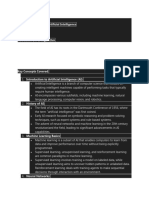0% found this document useful (0 votes)
15 views2 pagesAI Class Notes Introduction
The class notes provide an overview of Artificial Intelligence (AI), defining it as the science of making machines imitate intelligent human behavior and outlining its major branches, key algorithms, and applications across various sectors. Ethical considerations such as algorithmic bias and data privacy are also discussed, emphasizing the importance of responsible innovation in the field. Additional resources for further learning are provided, including books and online courses.
Uploaded by
Harsh VoheraCopyright
© © All Rights Reserved
We take content rights seriously. If you suspect this is your content, claim it here.
Available Formats
Download as PDF, TXT or read online on Scribd
0% found this document useful (0 votes)
15 views2 pagesAI Class Notes Introduction
The class notes provide an overview of Artificial Intelligence (AI), defining it as the science of making machines imitate intelligent human behavior and outlining its major branches, key algorithms, and applications across various sectors. Ethical considerations such as algorithmic bias and data privacy are also discussed, emphasizing the importance of responsible innovation in the field. Additional resources for further learning are provided, including books and online courses.
Uploaded by
Harsh VoheraCopyright
© © All Rights Reserved
We take content rights seriously. If you suspect this is your content, claim it here.
Available Formats
Download as PDF, TXT or read online on Scribd
/ 2











































































